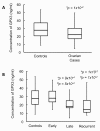Decreased levels of serum glutathione peroxidase 3 are associated with papillary serous ovarian cancer and disease progression
- PMID: 22017790
- PMCID: PMC3213073
- DOI: 10.1186/1757-2215-4-18
Decreased levels of serum glutathione peroxidase 3 are associated with papillary serous ovarian cancer and disease progression
Abstract
Background: Glutathione peroxidase 3 (GPX3) is a selenocysteine-containing antioxidant enzyme that reacts with hydrogen peroxide and soluble fatty acid hydroperoxides, thereby helping to maintain redox balance within cells. Serum levels of GPX3 have been found to be reduced in various cancers including prostrate, thyroid, colorectal, breast and gastric cancers. Intriguingly, GPX3 has been reported to be upregulated in clear cell ovarian cancer tissues and thus may have implications in chemotherapeutic resistance. Since clear cell and serous subtypes of ovarian cancer represent two distinct disease entities, the aim of this study was to determine GPX3 levels in serous ovarian cancer patients and establish its potential as a biomarker for detection and/or surveillance of papillary serous ovarian cancer, the most frequent form of ovarian tumors in women.
Patients and methods: Serum was obtained from 66 patients (median age: 62 years, range: 22-89) prior to surgery and 65 controls with a comparable age-range (median age: 53 years, range: 25-83). ELISA was used to determine the levels of serum GPX3. The Mann Whitney U test was performed to determine statistical significance between the levels of serum GPX3 in patients and controls.
Results: Serum levels of GPX3 were found to be significantly lower in patients than controls (p = 1 × 10-2). Furthermore, this was found to be dependent on the stage of disease. While levels in early stage (I/II) patients showed no significant difference when compared to controls, there was a significant reduction in late stage (III/IV, p = 9 × 10-4) and recurrent (p = 1 × 10-2) patients. There was a statistically significant reduction in levels of GPX3 between early and late stage (p = 5 × 10-4) as well as early and recurrent (p = 1 × 10-2) patients. Comparison of women and controls stratified to include only women at or above 50 years of age shows that the same trends were maintained and the differences became more statistically significant.
Conclusions: Serum GPX3 levels are decreased in women with papillary serous ovarian cancer in a stage-dependent manner and also decreased in women with disease recurrence. Whether this decrease represents a general feature in response to the disease or a link to the progression of the cancer is unknown. Understanding this relationship may have clinical and therapeutic consequences for women with papillary serous adenocarcinoma.
Figures


References
-
- Ovarian Cancer Home Page-National Cancer Institute. http://www.cancer.gov/cancertopics/types/ovarian
-
- Kim YM, Whang DH, Park J, Kim SH, Lee SW, Park HA, Ha M, Choi KH. Evaluation of the accuracy of serum human epididymis protein 4 in combination with CA125 for detecting ovarian cancer: a prospective case-control study in a Korean population. Clin Chem Lab Med. 2011;49:527–534. doi: 10.1515/CCLM.2011.085. - DOI - PubMed
-
- Zhu CS, Pinsky PF, Cramer DW, Ransohoff DF, Hartge P, Pfeiffer RM, Urban N, Mor G, Bast RC Jr, Moore LE, Lokshin AE, McIntosh MW, Skates SJ, Vitonis A, Zhang Z, Ward DC, Symanowski JT, Lomakin A, Fung ET, Sluss PM, Scholler N, Lu KH, Marrangoni AM, Patriotis C, Srivastava S, Buys SS, Berg CD. PLCO Project Team. A Framework for evaluating biomarkers for early detection: validation of biomarker panels for ovarian cancer. Cancer Prev Res (Phila) 2011;4:375–383. doi: 10.1158/1940-6207.CAPR-10-0193. - DOI - PMC - PubMed
-
- Cramer DW, Bast RC Jr, Berg CD, Diamandis EP, Godwin AK, Hartge P, Lokshin AE, Lu KH, McIntosh MW, Mor G, Patriotis C, Pinsky PF, Thornquist MD, Scholler N, Skates SJ, Sluss PM, Srivastava S, Ward DC, Zhang Z, Zhu CS, Urban N. Ovarian cancer biomarker performance in prostate, lung, colorectal, and ovarian cancer screening trial specimens. Cancer Prev Res (Phila) 2011;4:365–374. doi: 10.1158/1940-6207.CAPR-10-0195. - DOI - PMC - PubMed
LinkOut - more resources
Full Text Sources
Other Literature Sources
Miscellaneous

